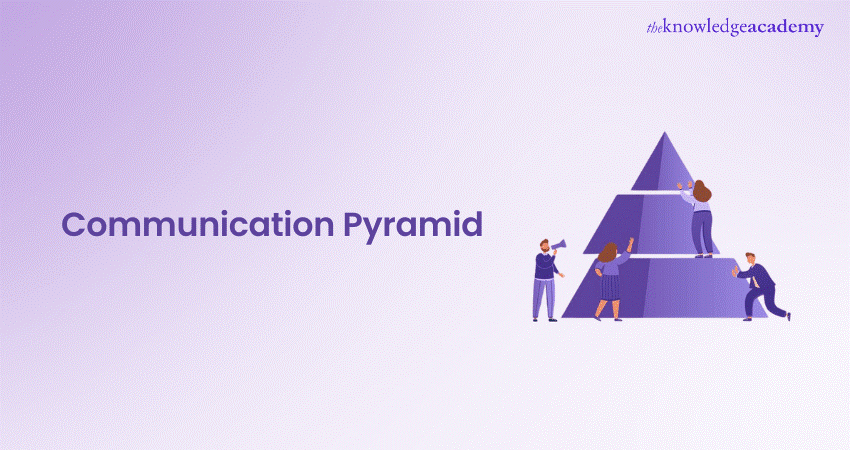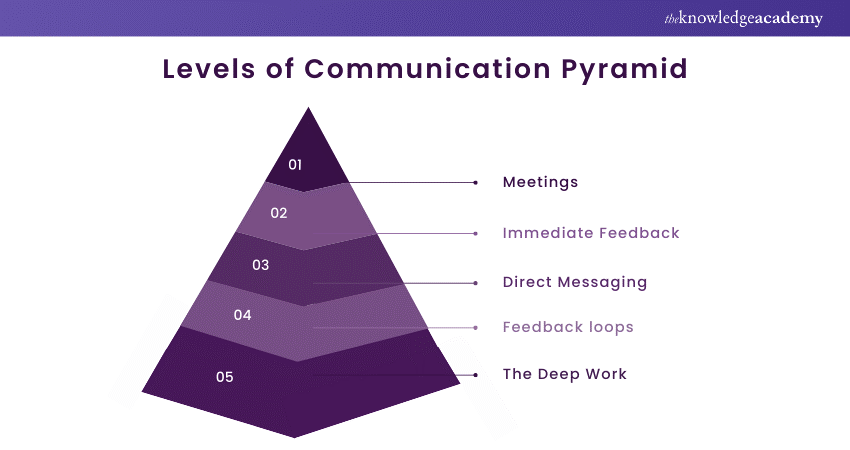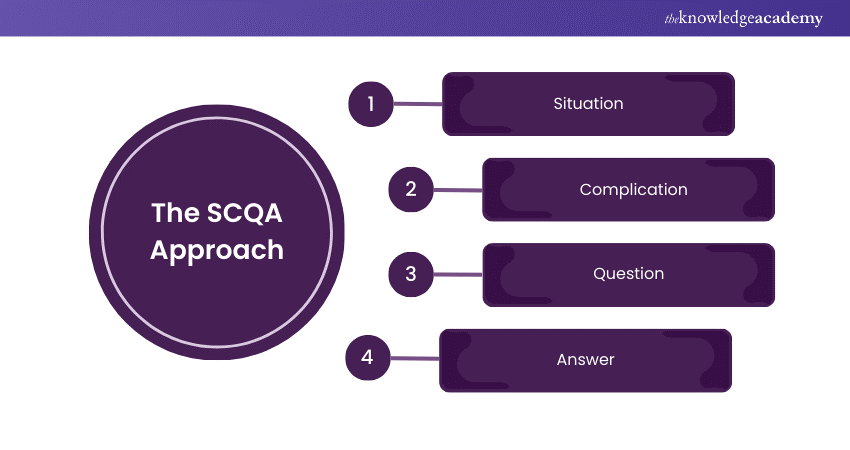We may not have the course you’re looking for. If you enquire or give us a call on 01344203999 and speak to our training experts, we may still be able to help with your training requirements.
We ensure quality, budget-alignment, and timely delivery by our expert instructors.

Communication is the cornerstone of human interaction, and its importance is magnified in the bustling corporate world. Amidst the whirlwind of emails, calls, and messages, capturing attention can be a daunting task. Enter the Communication Pyramid—a powerful strategy to cut through the noise and deliver your message swiftly and effectively.
This approach flips the traditional communication model on its head by starting with the conclusion and working backwards, allowing you to control the flow of your ideas in a unique way. Dive into this blog to explore how the Communication Pyramid can elevate your communication skills. Ready to enhance your corporate communication? Let’s get started!
Table of Contents
1) What is the Communication Pyramid?
2) The 7Cs of Effective Communication
3) Communication Pyramid in a Nutshell
a) Level 1: Deep Work
b) Level 2 : Feedback Loops
c) Level 3 : Direct Messaging
d) Level 4 : Immediate Feedback
e) Level 5 : Meetings
4) Conclusion
What is the Communication Pyramid?
The Pyramid Principle, also known as the Minto Principle, is a communication concept that follows an inverted pyramid approach, developed by Barbara Minto at McKinsey in the 1970s. This principle is applicable not only in executive settings but also in crafting persuasive arguments.
It suggests starting with the conclusion and then presenting the main points, followed by supporting facts and data. The aim is to eliminate unnecessary information and use clear, understandable language.
The 7Cs of Effective Communication
Coined by Allen H. Center and Scott M. Cutlip in 1952, the 7Cs of communication are often called the most effective communication model. Using the 7 Cs helps you make your business communication clear and concise.
With the 7Cs, the Pyramid Principle becomes second nature, and your message would become:
1) Clear: It should feature the main objective and be easy to understand.
2) Concise: Avoid repetitive and redundant words.
3) Concrete: It should be credible and backed with facts and data.
4) Complete: It should contain relevant information.
5) Correct: It should follow the rules of grammar and spelling.
6) Coherent: It must be relevant and connected to the primary goal.
7) Courteous: It needs to be friendly with no undertones of hostility or passive aggression.
Gain some extra boost of confidence in public speaking and daily interactions through our Effective Communication Skills Course – Sign up now!
Communication Pyramid in a Nutshell
There are five levels of effective communication, ranging from highest bandwidth to lowest bandwidth. These levels have become even more significant in the 21st century due to applications and technologies facilitating better communication. Let's explore these levels:

Level 1: Deep Work
This is the core of the team’s activities. Ideally, most working time would be spent at this level, free from interruptions. The focus is solely on work, which is shared with other team members once completed. At this level, communication occurs through the work produced.
Level 2: Feedback Loops
At this level, feedback is sought. Traditionally, this would be done via email—work is completed and sent to someone for feedback. Immediate responses are not expected; feedback is requested within a reasonable timeframe. There is still no interruption, but assistance from others is needed. Communication here is through feedback.
Level 3: Direct Messaging
At this level, feedback is required almost immediately. Quick back-and-forth communication is necessary when work is near completion and needs to be expedited. In traditional offices, this might involve walking over to someone’s desk, but technology now allows for direct messaging apps. This minimises interruption but indicates that prompt attention is needed, helping to speed up the completion process.
Level 4: Immediate Feedback
Sometimes, talking is faster for explaining nuanced ideas or demonstrating features. Instead of writing lengthy comments, showing and discussing work in real-time is more efficient. Voice messaging is used at this level, similar to traditional phone calls. Communication is quicker, but still respects the other person’s space by scheduling calls through chat first, allowing time to finish current tasks.
Level 5: Meetings
Face-to-face meetings are the last resort and not the default level. These require 100% involvement in the conversation and feedback loop, demanding full attention to the issue. While communication is swift, it comes at a cost. Therefore, meetings are used sparingly and only when necessary.
Thanks to this process, multiple projects and tasks are resolved at levels 1-3, reducing the need for meetings. Regular meetings are scheduled but held only when essential.
Looking to formulate effective communication strategies for diverse business contexts? Sing up for our Business Communication Course now!
How do You Use the Pyramid Principle?
First, you set the stage with the introduction, starting with the governing thought. Then, you move into the SCQA sequence, and finally, use vertical and horizontal logic to support your arguments with both inductive and deductive reasoning. Let’s explore these steps in detail:
Setting the Stage with Introductory Flow
To use the Pyramid Principle in an impactful way, it is essential to set the stage with a strong introductory flow. This involves:
1) Starting with the main conclusion or recommendation, which immediately addresses the most critical question your audience has. By leading with the conclusion, you capture attention and provide a clear focus for the discussion.
2) Following this, present the key supporting arguments that build the case for your conclusion. This structure ensures that your audience understands the overall message before delving into the details, making the communication clearer and more impactful.
Using Horizontal and Vertical Logic
At the top of the pyramid is your point—the key takeaway. Below are three arguments to support your idea, each of which must be based on reasons supporting it. The top of your pyramid must be actionable and supported by the arguments below. Essentially, you start with what you want and then support that with three reasons why you want it.
Organise your arguments in logical groupings, ranking them in order of importance and keeping them in discrete groups. For example, if you are discussing key metrics and sales automation, make your points about them first before moving on to sales automation.
Presenting your ideas in this order enables you to use horizontal and vertical logic:
1) The horizontal logic of the pyramid utilises either inductive or deductive reasoning:
a) Deductive reasoning makes a general statement and uses specific examples to validate that statement, such as: Birds can fly. I can fly, too; therefore, I am a bird.
b) Inductive reasoning infers a specific statement from general supporting arguments. For example, it rained on Monday, Tuesday, Wednesday, and Thursday. Therefore, it rains every day.
c) Vertical logic is the storyline, the question-and-answer dialogue. As you travel down the pyramid, you start with your main idea, pose questions, and answer them with supporting arguments.
Want to the learn the art of business-to-business marketing communication? Look no further than our B2B Communications Training – Register now!
The SCQA Approach
To apply the Pyramid Principle, you can use the SCQA framework, which stands for:

a) Situation: This is the context of the problem you are addressing, consisting of indisputable facts. The first step is to look beyond the symptoms to understand the "why."
b) Complication: This part involves evaluating the underlying reason for the problem and addressing the "so what" of the issue. It answers the "how."
c) Question: In this phase, you formulate a hypothesis by posing questions about the situation, with the aim of eventually finding answers.
d) Answer: Here, you answer the questions asked in the previous section. Once the hypothesis is confirmed, you can structure the information to present it in chronological order. This approach is evident when using horizontal and vertical logic to create an introductory flow.
What Are the Three Rules of Building a Pyramid Draft?
It’s worth learning the golden rules that underpin this pyramid communication method. These crucial elements ensure that your message is not only strong but also logical and easy to follow. With these three rules, you’ll be on your way to delivering clear, compelling messages that motivate action.
1) Start With the Answer First
The Minto’s pyramid principle flows in an inverted format. You can begin by stating your answer and then proceeding to make your arguments. Pyramid communication takes the form of an inverted pyramid, where the answer is at the top while your supporting ideas and reasons lie at the base.
When answering an executive’s question, begin with a conclusion followed by your three supporting reasons.
2) Compile a Summary of Your Arguments
After formulating an answer, create a summary of your argument’s main points. Use the rule of 3 to do this; make sure your reasons begin with the strongest point.
It’s an effective method of persuading your clients or audience when giving a presentation.
Here’s why the rule of 3 is an excellent strategy to use during sales pitches:
a) It Maximises Your Time With Your Audience: The time allocated to sales representatives is very brief; the rule of 3 helps you structure and present your argument within a short period. It allows you to capture your audience’s attention.
b) You are Forced to Prioritise: The rule of 3 forces you to choose the top three answers and find a way to present them in a well-structured argument.
c) It Makes You Look Confident and Decisive: Using the rule of 3 helps boost confidence during your presentations. Start your pitch by listing your reasons; this strategy makes you look decisive and composed. It also helps the audience remember your points.
Summarising your arguments helps with your flow during the presentation. It also allows you to arrange your train of thought in a more seamless sequence.
3) Arrange Your Arguments in a Logical Order and Support Them With Data Points
Ensure the reasons supporting your conclusion are related and complement each other. Arrange them in a logical order; this can be according to:
a) How much time each one takes
b) Structure and components
c) Importance/ rank
Combine this approach with the rule of 3 strategies, and you’re guaranteed to hook your audience. Pyramid communication is an excellent tool for communicating with senior executives and clients.
Conclusion
In conclusion, implementing the Communication Pyramid within your team can significantly increase efficiency and clarity. By structuring your communication and utilising feedback loops and direct messaging, your team can ensure that information flows seamlessly. We hope this blog helps you expand your communication skills and foster a collaborative environment for your workplace.
Nothing sells a brand like impactful Visual Communication! Ensure the same for your business with our Visual Communication Course – Sign up now!
Frequently Asked Questions
What is the Pyramid Framework for Communication?

This tool is used to structure information at pyramid levels and make a persuasive argument that holds the audience’s attention and compellingly delivers your message.
Why Should You Use the Pyramid Approach?

You should use the Communication Pyramid approach to get to the point in all communications as it ensures the audience is engaged. This allows for creating an appealing story that is easy to remember and understand.
What are the Other Resources and Offers Provided by The Knowledge Academy?

The Knowledge Academy takes global learning to new heights, offering over 3,000 online courses across 490+ locations in 190+ countries. This expansive reach ensures accessibility and convenience for learners worldwide.
Alongside our diverse Online Course Catalogue, encompassing 19 major categories, we go the extra mile by providing a plethora of free educational Online Resources like News updates, Blogs, videos, webinars, and interview questions. Tailoring learning experiences further, professionals can maximise value with customisable Course Bundles of TKA.
What is The Knowledge Pass, and How Does it Work?

The Knowledge Academy’s Knowledge Pass, a prepaid voucher, adds another layer of flexibility, allowing course bookings over a 12-month period. Join us on a journey where education knows no bounds.
What are the Related Courses and Blogs Provided by The Knowledge Academy?

The Knowledge Academy offers various Communication Skills Course, including the Assertiveness Skills Training and the Public Speaking Course. These courses cater to different skill levels, providing comprehensive insights into Visual Communication.
Our Business Skills Blogs cover a range of topics related to Communication, offering valuable resources, best practices, and industry insights. Whether you are a beginner or looking to advance your Communication skills, The Knowledge Academy's diverse courses and informative blogs have got you covered.
Upcoming Business Skills Resources Batches & Dates
Date
 Assertiveness Skills Training
Assertiveness Skills Training
Fri 4th Apr 2025
Fri 6th Jun 2025
Fri 1st Aug 2025
Fri 3rd Oct 2025
Fri 5th Dec 2025






 Top Rated Course
Top Rated Course



 If you wish to make any changes to your course, please
If you wish to make any changes to your course, please


